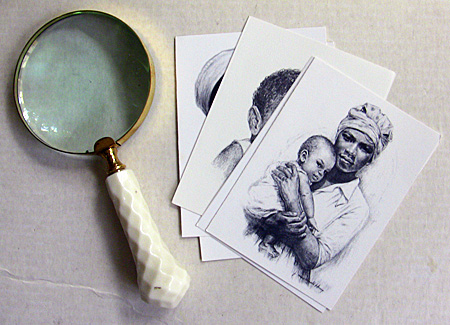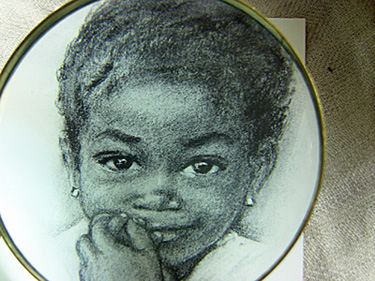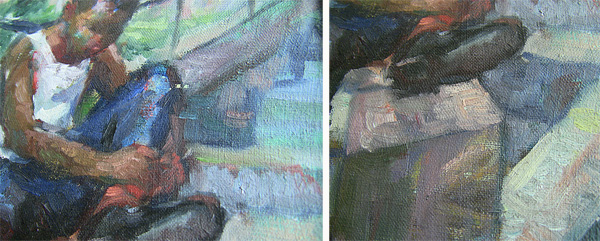Friday at Auction Finds is a day I answer readers’ questions. I try to guide readers to resources to help them determine the value of their items. I’m not able to appraise their treasures, but I can do some preliminary research to get them started. So, what I offer are market values based on prices I find on the web, not appraisal for insurance purposes that I suggest for items that have been determined to be of great value.
I have two questions today about whether artwork by J. MacDonald Henry are original charcoals.

Question:
How can I tell if I have an original charcoal sketch from JMH?
Question:
I have a print of the mother and child and would like to know what it’s worth, as an original and as a reprint. I could send you a picture and maybe you can tell me if it’s original or not. It is on a thick piece of paper and the frame was removed and it’s shadowed lighter where the frame was.
Answer:
Both readers were prompted to contact me after seeing a blog post I wrote two months ago about the artist J. MacDonald Henry, and her familiar mother and child print. I bought one of the inexpensive reproductions of the portrait years ago, and still have some note cards from what is said to be her “Faces of Jamaica” series.
MacDonald was an internationally known artist who was born in Jamaica in 1960. Her mother and child portrait seemed to be the most popular of her works. I learned that she died more than a decade ago.

How to determine if it’s an original or reproduction
If the artwork is in a frame, I’d suggest that it be removed and examined out of frame. If it is an original charcoal, the marks on the paper should have some texture. The reader can eyeball it, but I’d suggest using a magnifying glass to examine the drawing, getting as close as possible to it. Think of what original pencil (or charcoal) marks would look like.
Charcoal marks, like most other medium, are made on a surface and do not penetrate (watercolor does). If there is some texture, the artwork is likely an original. If the surface is flat and smooth, it is more likely a reproduction.
Googling, I found an original for sale on eBay by a dealer in the United Kingdom. It is a portrait of a Jamaican man, and the listing includes a close-up of the man’s head showing the charcoal brushes. It certainly looks like an original on paper.
My note cards are reproductions, as most note cards and greeting cards are. To test them, I pulled out my magnifying glass and took a look. I could see that the surface was flat (I could also tell just by looking at one of them).
This is something that can be done for most artwork, but it’s hard to do if the work is in a frame. Sometimes, it’s difficult for me to tell the difference on some artwork.
Oil paintings can be easy to identify. With the magnifying glass, look for brushstrokes on the canvas that have texture. If the strokes are flat and only give the impression of strokes, it’s not an original.

Lithographs are lot easier to detect. I used to buy a lot of lithographs, which are original prints that have been printed by the artist (or his/her designee). I was never sure about how to tell the difference between a lithograph and a reproduction. Then I learned to check the edges of the image: lithographs have uneven edges, reproductions have straight clean edges.
If either reader is still unsure about what they have, I’d suggest they take their works to an art gallery or framer who should be able to easily tell them if they have an original.
The value of a MacDonald Henry portrait
I asked the reader to send me a photo of her portrait, but I haven’t heard back from her. It may be difficult, though, to make a determination of originality without seeing the actual artwork in hand.
As for the value, I could find only one portrait that looked to be original – the Jamaican man – that was selling for $619 on eBay. A Chicago auction house sold portraits of two children as charcoal on paper, but I doubt that they were originals. They sold for $49 as a pair.
Some of MacDonald Henry’s works were listed on some websites as original charcoals, which wasn’t likely because I repeatedly saw the same image, and I doubt that she created more than one original of the same. I suspect that they were reproductions. Those portraits were selling for or sold for about $20 or less.

I have Jamaican Girl and man.i do not understand.uf she were born 1960 when did she do these works.i believe they are original.
Sorry, but I have no info on the dates of her works. Since she didn’t affix a date to them, it’s hard to determine when they were done.
This bio says she had her first 1-woman show in 1960, hosted by the PM wife in Jamaica, so must have already been well-known. She must have been born in the 40s minimum.
https://www.angelfire.com/ny/hearl/jeannes_info_page.html
Hello, thank you for all of this information. I just purchased the mother and child print and also wondered of its value. I think it might be a lithograph since it doesn’t have smooth edges, one side is fairly rough like it was torn, and the other three sides aren’t smooth either like a poster. One thing that stands out to me is that the print has a letter c with a circle after the signature which I think is a copyright logo. Searching the web, I’ve found images with and without that logo. What is the difference? I’m not an art connoisseurs but I was taken by the image so I bought it. Thank you for your time and assistance!
Sorry, Mari, but I don’t know the answer. Try finding an auction house near you via auctionzip.com that offers free-appraisal days. Drop by and ask them to take a look. Good luck, Sherry
Jamaica bookshops and the airport giftshops are the only places, i have seen them.